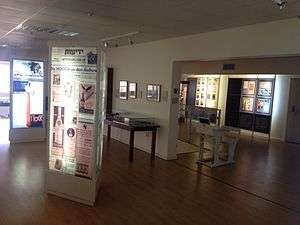German-Speaking Jewry Heritage Museum Tefen
 | |
| Established | 1968 |
|---|---|
| Location | Sderot HaTa'asiya, Tefen, Northern District, Israel |
| Type | Cultural-historical Museum |
| Curator | Ruthi Ofek |
| Website | omuseums.org.il |
The German-Speaking Jewry Heritage Museum (Hebrew: המוזיאון ליהדות דוברת גרמנית) is a museum in the Tefen Industrial Park in the north of Israel and is carried by The Open Museum Tefen, to which belong several other museums and exhibitions. It was founded in 1968 in Nahariya by Israel Shiloni and moved in 1991 to Tefen.
History
The museum developed from the collection of the Nahariyan Israel Shiloni, who collected historical material at first from friends and acquaintances to make the history of the German-speaking immigrants to Palestine comprehensible for the next generations. A little exhibition developed from this collection in 1968 and was located in rooms of the municipality of Nahariya.[1][2]
In 1991 the museum moved to the Tefen Industrial Park, eastern of Nahariya and founded by Stef Wertheimer, where it is located since then. In 2004 the museum and the Association of Israelis of Central European Origin signed a contract of cooperation. In 2005 the museum had a new opening.[1][2]
Exhibition
History of German-Speaking Jewry
The exhibition of the museum is spaced on 400 m2 in two floors. It focuses on the rich history of the German-speaking Jews of Central Europe till the Second World War and on their contribution to development, economy and culture of the area, where the Israeli state was founded later, as well as to Israel itself. Although the topic is always present, the museum decided not to be a Holocaust museum.[1][2]
The museum artifacts are displayed according to topic and include interactive presentations, prepared following in-depth research conducted by experts, on industry and commerce, architecture, medicine, law, settlement, education and performing arts. The presentations use clear and fascinating visual language alongside authentic photographs and films to expose spectators to the contribution of Central European Jews in all of these areas. Through request documentary films can be shown, which had been produced by the Open Museum itself and which tell about the history of German speaking immigrants to Israel. An elevator is available in the building.[1][2]
Hermann Struck Exhibition
In the exhibition rooms works of the painter and etcher Hermann Struck (1876–1944) are shown. The exhibition focuses on Struck's artistic activities during his years in Haifa. Beyond that it shows materials from the personal bequest of the artist.[1][2]
Original Settler Shack
A specialty of the museum is the original of a settler shack from the early days of Nahariya. Before it had been transported in 2010 to the museum, it was standing since 1936 at its old place. It is authentically furnished for the time of Nahariya's establishment, with a bed, a commode, old books and a simple shower device.[3]
Hugo-Zwi Schatzman (1900–1976) and his wife Lea-Gertrud, née Wallach (1906–1983) immigrated to Palestine from Germany in the year 1934. In preparation for their emigration they joined the league Blau-Weiß (= Blue-White) in the Zionist youth movement, which followed the zionist program of Hakhshara, where Hugo-Zvi learned to be a carpenter and Lea-Gertrud to be a barber and nursemaid. After their arrival in Palestine their group was sent to the kibbutz Ein Harod. In 1935 the couple moved to Nahariya and bought a parcel of land there at the corner of Weitzman and Hanita street, where they built two settler shacks. In the bigger one of the two shacks they lived and used the smaller one as a storage. With the years the usage of the shacks adapted to the changing needs of the owners. In 1946 the Schatzmans sold the parcel to the family Pisker, which built a stone house at the side of the shacks. In the year 2010 the family sold the parcel. When a new apartment building was supposed to be built there, older Nahariyans (especially the earlier glas factory owner Andreas Meyer) organised the preservation of the bigger shack as a historical testimony of the settler years. The Israeli society for the preservation of historical legacy took over the project and transferred the shack to the museum in Tefen, where it is visitable since then.[3]
Library
The book collection of the museum contains more than 5000 books, mostly in German language, which convey a broad overview of the literary activities of German Jews in the fields of prose, poetry, philosophy, science and politics, as well as of scientific literature dealing with Central Europe's Jewry.[1][2]
Archive
The museum's archive preserves various historical documents like certificates, letters, photographs and numerous objects, given to the museum. This way it helps scientists from Israel and abroad with their research about the history of German-speaking Jewry. Scientists with different interest, like Art history, can find interesting material in the archive.[4][2]
External links
- Homepage of the German-Speaking Jewry Heritage Museum Tefen
- The "Association of Israelis of Central European Origin"
References
- 1 2 3 4 5 6 http://www.omuseums.org.il/eng/mmty_about/About_the_Museum
- 1 2 3 4 5 6 7 http://www.irgun-jeckes.org/?CategoryID=253&ArticleID=3461
- 1 2 http://www.omuseums.org.il/eng/mmty_shed/The_Shack_from_Nahariya
- ↑ http://www.omuseums.org.il/eng/mmty_Archive/Archives
Coordinates: 32°58′49″N 35°16′22″E / 32.9803°N 35.2729°E